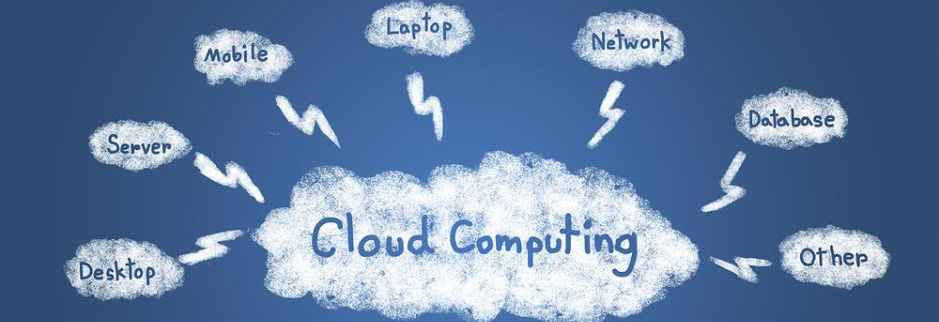
It seems these days hardly a day goes past when you don't hear the term 'Cloud Computing'. Everything, it appears, is in the Cloud. From your ability to type a letter or listen to your favourite songs, to even to setting your home's heating thermostat. It seems we need the Cloud for almost everything – not least in the web hosting arena. Despite its near ubiquitous status, how many of us can really explain what the Cloud is?
We all grew up with computers…
Most of us have grown up with computers. Our PCs have always had their own storage devices, and this has traditionally meant a computer having a hard disk where data is recorded. Such disks can usually store several hundred gigabytes of data and this can include pictures, documents, spread sheets – whatever is it that you need to digitally store.
Enter the server…
When data is stored on an individual computer it is inaccessible to other people. Unless you have a user name and a password you cannot access the data a computer stores. Rather than lock data up in this way, to improve efficiency many offices installed a server where data could be collected at a central point.
The server had its own storage that an office shared. However, each PC attached to a server still had its own storage capability. In addition, each PC needed its own software – its own email client, its own word processing software, its own accounting spread sheets – whatever the user needs to do his or her job.
Keeping an office going in this way often meant that a company employed a full-time system administrator to ensure an office's computer system was in order and up and running. The administrator would be responsible for linking computers, upgrading software – everything that was required. However, the advent of the Internet changed all of this.
Enter the Internet…
Almost as soon as the Internet was a reality, online services became available that offered an alternative to the traditional approach to computers. Services such as Microsoft's Hotmail were a taster of what was to come.
Hotmail users could access an email account via the Internet, completely negating the need for a physical server to send and receive email. Rather than requiring their own internal email system, individuals and companies could access Hotmail only when they needed it. They didn't need to do anything to maintain their account – that was all Microsoft's responsibility. Fast forward to today, and things have advanced to the extent that a company's entire IT department can be replicated in the Cloud. But what does this really mean?
Enter the Cloud…
Formerly, web hosting was more similar to the office network except for as an industry it provided computers for a singular purpose – to make websites available on the Internet. To do this, a web host would usually own a number of servers, and people would rent space on each physical machine. Depending on your needs, a web hosting customer would either rent a certain amount of the space available on server. Like with the office network, each physical machine would have its own storage capability, its own processing power and offer a level of bandwidth for access to the Internet. If the storage and resources on a computer were not used, they were still paid for, despite bot being used. Although this traditional approach to web hosting is still dominant, Cloud Computing offers a very different approach.
How is Cloud Computing different?
Simply put, Cloud Computing is not storing data on a computer's hard disk, but on another computer linked to your computer through the Internet. Likewise, rather than using software stored on your own computer, Cloud Computing allows people to use software which is stored on another computer somewhere else entirely – an unknown location beyond "in the Cloud".
Rather than having lots of machines each with its own storage and resources, the storage and resources of each machine are combined with that of other machines. This is why it is called the Cloud – envisage a mass of digital capability that is not tied to an individual machine but the result of lots of machines being combined and you might start to be able to envisage the could.
Rather than renting space on a server, you buy the resources you need that are stored in the Cloud, and usually this means you only pay for what you use – not a penny more. This alone has been a driving factor in the Cloud's phenomenal growth.
What does Cloud Computing do?
These days rather than have their own servers, companies' entire IT functions can be managed by third-parties. Rather than each worker having software for email and calendars, etc. on their own computers, this software is rented from providers who operate in the Cloud. And rather than storing everything on a server offering finite storage space, everything is stored in a (reasonably) infinite cloud.
Every conceivable business function has been moved to the Cloud. Likewise, web hosting operations have moved to the Cloud in their entirety – rather than using lots of their own servers web hosts now rent resources in the Cloud which are then passed on to their customers. But it has gone beyond this. With all that computing power available big companies involved in innovation have been able to hire processing power to manipulate huge quantities of data and turn it into something a company can make meaningful sense out of. This is the so called 'Big Data' revolution.
So only businesses use the Cloud?
Anyone who uses a Gmail, Outlook account, owns a Facebook or Instagram account, or buys anything on Amazon.com, uses the Cloud. Anything that can be done remotely over the Internet probably utilizes the Cloud. However, businesses are more likely to use different aspects of the Cloud than individuals. Businesses may use Software-as-a-Service (SaaS) and subscribe to Internet-based applications it needs to do its business. Or they may use Platform-as-a-Service (PaaS) which allows businesses to design applications required for their workflow and access them remotely. Or businesses might even adopt Infrastructure-as-a-Service (IaaS) and rent out resources from a host of providers (including Google, Microsoft, Rackspace and Amazon) to provide services which are in turn provided to other companies.
So what about the future?
So far everything that a company previously needed its own IT resources to achieve can be done in the Cloud. But in the future expect everything to be in the Cloud – it will be more than ubiquitous. Scientific research, design, medical treatments, commerce and all aspects of industry – absolutely everything will benefit from having computer processing power and resources available without investment beyond usage costs.



